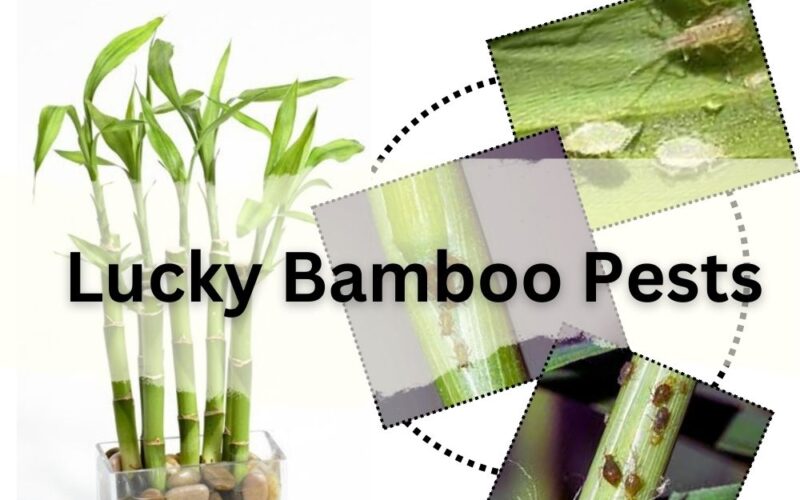Join this article to learn how to identify lucky bamboo pests with their images and symptoms and get rid of them with practical remedies.
Lucky bamboo (Dracaena sanderiana) is one of the most popular indoor bamboo types. However, this plant is a hardy and low-maintenance indoor plant and relatively resistant to pests, but may affected by tiny bamboo bugs.
In this article, I want to consider common indoor plant pests that can cause problems for your lucky bamboo. various factors can have an impact on the sensitivity of lucky bamboo to pests including:
- Overall health
- Growing conditions
- Cleanliness of its environment
here, I first will help you detect the lucky bamboo pests, and then you will find out how to get rid of them. let’s dive into it.
➡ You can also hear the audio version of this article.
Identifying Lucky Bamboo Pests

I know it’s not an Entomology class but you must know the first step to get rid of lucky bamboo pests, is to detect them correctly. Most of these annoying guests are tiny, so, it will be a good idea to grab your magnifying glass.
Here, I introduce 8 bamboo bugs to you. some of them are most common such as spider mites and some are not. However, I tried to list almost all reported insects on bamboo. To make their detection easy for you, I will provide you with their images and a brief overview of their appearance.
Due to most of them being tiny bugs in houseplants, you often first spot their damage on infested plants before seeing the culprits. So I also will tell you about their symptoms. let’s get going.
1- Aphids on Bamboo
(Aphidoidea)

Lucky Bamboo Aphids Appearance
- Aphids are approximately 1 to 4 millimetres (mm) in length.
- These tiny houseplant bugs have various colours, such as green, yellow, black, brown, or pink.
- Bout their body, as you see them in the above picture, these lucky bamboo pests are soft-bodied, pear-shaped insects with long antennae and two short tubes (cornicles) on their rear end.
Damage of Aphids on Bamboo
To find the symptoms of Aphids on bamboo you must first find their habitancies. These lucky bamboo pests feed on the plant’s sap by piercing the leaves and stems with their needle-like mouthparts. So the Aphid damages on your lucky bamboo will be:
- Yellowing or wilting of leaves.
- Distorted or curled leaves.
- Sticky honeydew residue on the plant’s surface.
- Sooty mould growth on the honeydew.
2- Lucky Bamboo Mealybugs
(Pseudococcidae)

Lucky Bamboo Mealybugs Appearance
First, let’s get familiar with their appearance:
- Mealybugs on houseplants are usually around 1 to 5 mm in size.
- Detecting these lucky bamboo pests is very easy because adult mealybugs are typically covered in a white, waxy, cottony substance that gives them a cotton-ball-like appearance.
- Their shape, these white tiny bugs on houseplants are oval-shaped with short legs and antennae.
Damage of Mealybugs on Bamboo
Similar to aphids, these annoying guests feed on plant sap, weakening the plant and potentially transmitting diseases. As a result, you will see the below symptoms on your bamboo plant:
- A white, cottony substance on the plant that is adult mealybugs. These lucky bamboo pests love to hang out under leaves.
- Yellowing or wilting of leaves.
- Growth stunted or distorted.
- Honeydew and sooty mould.
3- Lucky Bamboo Scale Insects
(Coccidae)

Lucky Bamboo Scale Insects Appearance
- You may see the Scale insects in various sizes, but they are generally small, ranging from 1 to 5 mm.
- These small bugs have various colours, including brown, tan, or even translucent.
- If you look closely enough, you will find them as small, flat, oval or round, and immobile creatures, and they may have a protective shell-like covering.
Damage of Scale Insects on Bamboo
Scales are culprits for feeding on the sap of your bamboo plant and can weaken the plant over time. so, they will cause the following Symptoms:
- Small, hard, shell-like coverings on stems and leaves.
- Yellowing or browning of the foliage.
- Reduced plant vigor.
4- Lucky Bamboo Spider Mites
(Tetranychidae)

Lucky Bamboo Spider Mites Appearance
- Spider mites are one of the most common lucky bamboo pests. They are tiny bugs on houseplants, typically less than 1 mm in size.
- The colours of these lucky bamboo pests can be red, green, yellow, or brown, depending on the species and environmental factors.
- Seeing them with the naked eye is hard but if you spot them under a magnifying glass, Spider mites have an oval or elongated body shape, and they may produce fine silk webbing, especially when populations are high.
Damage of Spider Mites on Bamboo
Spider mites feed on plant sap by piercing plant cells, leading to cell damage and dehydration. So, these lucky bamboo pests will cause the following Symptoms on your lucky bamboo.
- Fine webbing on the plant.
- Stippling or discolouration on leaves.
- Leaves may become speckled or bronze in colour.
5- Lucky Bamboo Fungus Gnats
(Sciaridae)

Lucky Bamboo Fungus Gnats Appearance
- Adult fungus gnats are small, about 2 to 3 mm in length. You usually spot their population like a black cloud near your plant.
- As you find out from their names, they are typically dark grey or black, and their wings are transparent.
- Fungus gnats resemble small, delicate flies with slender bodies and long legs.
Damage of Fungus Gnats on Bamboo
However, you spot the adult fliers around the foliage but the main culprits are their larvae. Their larvae feed on organic matter in the soil and can harm the plant’s roots. So, you will spot the below symptoms:
- Yellowing or wilting of the plant.
- Reduced growth and health.
- Presence of small, dark flies in the vicinity.
6- Lucky Bamboo Whiteflies
(Aleyrodidae)

Lucky Bamboo Whiteflies Appearance
- Adult whiteflies are very small, around 1.5 to 2.5 mm in length.
- They are white or pale yellow and have powdery wings.
- Whiteflies are tiny lucky bamboo pests with a moth-like appearance and wings that are held roof-like over their bodies.
Damage of Whiteflies on Bamboo
Unlike the fungus gnats, the adult Whiteflies are the main harming stages. These lucky bamboo pests feed on the undersides of leaves. Another damage to your plant is the transmission of plant viruses by them. so, an infested bamboo plant will have the following symptoms:
- Yellowing or wilting of leaves.
- Sticky honeydew on the plant.
- A cloud of whiteflies when the plant is disturbed.
7- Lucky Bamboo Thrips
(Thripidae)

Lucky Bamboo Thrips Appearance
- Thrips are slender and usually measure around 1 to 2 mm in length.
- These lucky bamboo pests can be brown, black, or yellowish, and some have fringed wings.
- If you see them with your magnifying glass, Thrips have elongated bodies with distinctive, narrow wings, and they may appear almost thread-like.
Damage of Thrips on Bamboo
These annoying guests rasp the surface of lucky bamboo leaves and suck out plant fluids. Some people are concerned about thrips bites and ask me “Can thrips bite humane?” I discussed it in my previous article. It will cause the following symptoms in your plant:
- Stippling or silvering of leaves.
- Distorted or twisted growth.
- Dark faecal specks on leaves.
to prevent this pest, it is important to know the ways thrips come from.
8- Lucky Bamboo Leafhoppers
(Cicadellidae)

Lucky Bamboo Leafhoppers Appearance
- Leafhoppers are small insects, with adults ranging from 3 to 13 mm in length. So, they can be visible to the naked eye.
- These lucky bamboo pests come in various colours, including green, brown, and various patterns.
- Their shape, Leafhoppers have wedge-shaped bodies, and they are known for their large hind legs adapted for jumping.
Damage of Leafhoppers on Bamboo
Leafhoppers can hurt your bamboo plant in two ways. First, they feed on plant sap, and after that, these lucky bamboo pests may potentially transmit plant diseases. So, they will cause the below symptoms on your lucky bamboo:
- Yellowing or browning of leaves.
- Stippling or leaf discoloration.
- Potential plant diseases due to their role as vectors.
How to Get Rid of Bamboo Bugs

After you detect lucky bamboo pests, now, come on to show you how to get rid of bamboo bugs. Because most of the Lucky bamboo pests’ treatments are similar for various bugs, in the following I provide you with an almost comprehensive guideline to get rid of bamboo bugs. You can follow several methods depending on the type of lucky bamboo pest infestation.
- Prune Affected Parts to Lucky Bamboo Pests
Trim and remove heavily infested leaves and stems to reduce the pest population and improve the plant’s overall health.
- Manual Removal of Lucky Bamboo Pests
For larger pests like mealybugs, scales, or spider mites, use a soft brush, cotton swab, or a gentle stream of water to remove the pests from the plant physically.
- Beneficial Insects to Control Lucky Bamboo Pests
Release beneficial insects like ladybugs or lacewings into your indoor garden to naturally control soft-bodied pests.
- Sticky Traps for Lucky Bamboo Pests
Use yellow sticky traps to catch flying pests like whiteflies or fungus gnats.
Use the Natural Pesticides
- Insecticidal Soap spray
For soft-bodied pests like aphids and mealybugs, treat the plant with insecticidal soap, following the product’s instructions. It can suffocate and kill the insects on contact.
Neem oil is effective against a wide range of pests. Dilute it according to the instructions and apply it to the plant, covering both sides of the leaves.
- Horticultural Oil
Horticultural oil can help control scales and mealybugs. Follow the label instructions and avoid using it during extreme temperatures.
General recommendations
- Take several rounds of treatment to completely eliminate the pests.
- Avoid using harsh chemicals or pesticides that could harm the plant, especially since lucky bamboo is sensitive to certain chemicals.
- Always follow the instructions on any pest control products you use and be patient in your efforts to protect your lucky bamboo.
How to Prevent Lucky Bamboo Pests

There is a general rule: prevention is easier than treatment. Preventing pest infestations in your lucky bamboo is often more effective than dealing with them after they occur. Come on to tell you some tips to prevent lucky bamboo pests from affecting your plant:
- Isolate the Infested Plant
If you have multiple plants, isolate the infested lucky bamboo to prevent the lucky bamboo pests from spreading to healthy ones.
- Quarantine New Plants
Before bringing a new plant home, keep it isolated from your existing plants for a few weeks to ensure it’s pest-free.
- Inspect Plants Before Purchase
When buying new plants, carefully inspect them for any signs of lucky bamboo pests or damage. Avoid purchasing plants with visible issues.
- Maintain Good Plant Health
Healthy plants are less susceptible to pests. Ensure your lucky bamboo receives proper care, including adequate light, appropriate watering, and balanced nutrition.
- Avoid Overwatering
Lucky bamboo prefers consistently moist soil, but overwatering can lead to root rot and attract fungus gnats. Make sure the plant’s pot has proper drainage.
- Regularly Clean and Prune
Remove dead or yellowing leaves and other debris from the plant to minimize hiding spots for lucky bamboo pests.
- Monitor for Early Signs
Regularly inspect your lucky bamboo for any early signs of pest infestation, such as discoloured leaves or sticky residues.
- Maintain Humidity
Lucky bamboo thrives in a moderately humid environment. Maintaining proper humidity levels can deter certain pests.
- Avoid Overcrowding
Crowded plant groupings can create conditions that are more favourable for pest infestations. Ensure adequate space between your plants.
- Use Clean Potting Mix
If you’re repotting or adding soil to your plant, make sure the potting mix is free from lucky bamboo pests and diseases.
- Inspect Outdoor Plants
If you have outdoor plants that you bring indoors during colder months, thoroughly inspect them for pests before reintroducing them to your indoor garden.
Conclusion
Now you have become familiar with 8 lucky bamboo pests including Aphids, Mealybugs, Scale Insects, Spider Mites, Fungus Gnats, Whiteflies, Thrips, and Leafhoppers. You also learned how to detect them by images and a brief overview of their appearance and symptoms. I told you about how to get rid of them and prevent reinfestations.
What were your bamboo bugs? Did you know other remedies that I didn’t mention above? Please share your ideas and experiences below this page. you can also ask me your questions; I will answer as soon as possible.

Elahe Rabiei
Hi, I’m Elaheh. My Academic major is plant protection, and houseplants are my expertise. As a houseplant lover, my house is full of indoor plants and it is my passion to take care of them. Hence, I’m here to share my knowledge and experience about growing healthy houseplants. I am also a plant protection advisor, so feel free to ask me any questions you may have.

